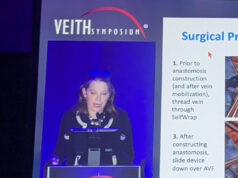
It has been suggested by some, such as Khalid Bashar (University Hospital Limerick, Limerick, Ireland) et al in the International Journal of Surgery in 2015, that cephalic veins smaller than 3mm in diameter used for arteriovenous fistulas (AVFs) are more prone to maturation failure than larger veins. Now, however, a new study in Hemodialysis International has suggested that balloon angioplasty for maturation assistance can be as effective in these smaller veins as in ones larger than 3mm.
The study authors, led by Tsung-Chi Kao (Chang Gung Memorial Hospital, Taoyuan City, Taiwan), emphasise the view that small-diameter veins are commonly “considered to have poor outcomes” for AVF maturation. It was with this in mind that they investigated the long-term patency outcomes of these veins in the context of angioplasty assistance.
Their work builds on that of Bo Wang and Amit Rao (Zucker School of Medicine at Hofstra/Northwell, Hempstead, USA) et al, who in 2021 published research in the Annals of Vascular Surgery that found “lower but still favourable” rates of maturation in small-vein AVFs when balloon-assisted maturation was carried out. Wang and Rao concluded that the procedure opened the door to “potentially reduc[ing] complications related to prosthetic dialysis access”.
For this study, Kao and colleagues devised a single-centre study including 61 patients, of whom 22 experienced full maturation of their AVF without extra intervention. The remaining 39 AVFs failed to mature, and 38 of these underwent a salvage balloon angioplasty procedure while one patient received peritoneal dialysis. From the 38, 36 achieved a functional AVF as a result of the assistance.
A Kaplan-Meier analysis “revealed no significant differences between the [unassisted] AVF and balloon-assisted maturation groups”, with primary functional patency for the former (p=0.503) proving similar to the latter (p=0.499). At one-year follow-up, primary functional patency in the angioplasty group was 94.7% compared with 93.1% in the unassisted maturation group. At three years, patency was 88.0% compared with 93.1% and at five years it was 79.2% compared with 88.3%. The authors did not find any significant difference in the duration of primary functional patency and assisted primary functional patency (p>0.05).
On a multivariate analysis, both the number of angioplasty procedures a patient underwent, as well as the diameter of the vein used, were found to be independent predictors of primary functional patency in both groups. A 1mm increase in the size of the vein was associated with a 0.13-fold probability of decreased patency duration (hazard ratio [HR]=0.13, 95% confidence interval [CI]: 0.02–0.99, p=0.049). Two balloon-assisted maturation procedures were associated with a 2.885-fold increased likelihood of decreased primary functional patency duration (HR=2.885, 95% CI: 1.09–7.63, p=0.033) compared with having only one such procedure.
Summarising the findings in their discussion, the authors state: “Balloon-assisted maturation is a relatively effective salvage management option with an acceptable long-term patency rate, even for small cephalic veins.”












